Transmission electron microscopic study of the fine-grained vein matrix in the Suizhou L6 meteorite
2016-10-20XieXiandeWangJianboGuXiangpingXiongYiJiaShuangfeng
Xie Xiande·Wang Jianbo·Gu Xiangping·Xiong Yi·Jia Shuangfeng
ORIGINAL ARTICLE
Transmission electron microscopic study of the fine-grained vein matrix in the Suizhou L6 meteorite
Xie Xiande1,4·Wang Jianbo2·Gu Xiangping3·Xiong Yi2·Jia Shuangfeng2
The mineralogy of shock vein matrix in the Suizhou meteorite has been investigated by optical and transmission electron microscopy.It was revealed that the vein matrix is composed of majorite-pyrope garnet,magnesiowu¨stite,andringwoodite,withFeNi-FeSintergrowths.The observation and character of ring-like selected electron diffraction(SAED)patterns indicate that the idiomorphic garnet crystals in the vein matrix have different orientations.The polycrystalline nature of magnesiowu¨stite is also confirmed by a ring-like SAED pattern. Both garnet and magnesiowu¨stite crystals showed sharp diffraction spots,signifying the good crystallinity of these two minerals.The SAED pattern of cryptocrystalline ringwoodite shows only diffuse concentric diffraction rings.FeNi metal and troilite(FeS),which were molten during the shock event,occur in the matrix as fine eutectic FeNi-FeS intergrowths filling the interstices between garnet and magnesiowu¨stite grains.Based on the phase diagram of the Allende chondrite and the results of this TEM study,it is inferred that majorite-pyrope garnet first crystallized from the Suizhou chondritic melt at 22-26 GPa,followed by crystallization of magnesiowu¨stite at 20-24 GPa,and then ringwoodite at 18-20 GPa.The eutectic intergrowths of FeNi-metal and troilite are proposed to have crystallized during meteorite cooling and solidified at the last stage of vein formation.
Suizhou meteorite·Shock vein matrix·Highpressure minerals·Transmission electron microscopy
1 Introduction
Chondritic meteorites often contain shock-produced melt veins that have the same chemical composition as the chondritic host rock.For most vein-bearing chondrites,vein width ranges from 0.1 to 10 mm,but the average width for melt veins in chondrites is estimated at 0.5-1 mm(Xie et al.2011).The mineral assemblages in the melt veins of L-group chondrites differ considerably from those found in heavily shocked H-group chondrites.Shock melt veins in L-group chondrites contain shock-produced highpressure polymorphs,such as ringwoodite,majorite,lingunite,and high-pressure liquidus phases,such as majoritic garnet and magnesiowu¨stite(Binns et al.1969;Smith and Mason 1970;Coleman 1977;Madon and Poirier 1979;Chen et al.1996;Xie et al.2001,2011),whereas shock melt veins in heavily shocked H-chondrites contain mainly low-pressure mineral assemblages,such as recrystallized olivine and pyroxene(Chen and Xie 1997;Kimura et al. 1999,2002;Sharp and DeCarli 2006).The differences in the mineral constituents of shock melt veins in L-group and H-group chondrites clearly indicate differences in the shock histories of these meteorites(Chen et al.1996;Xie et al.2001,2011).
The Suizhou L6 chondrite fell to earth at Dayanpo,situated 12.5 km southeast of Suizhou city in Hubeiprovince,China,on 15 April 1986.It was found that the melt veins in the Suizhou meteorite morphologically are the simplest,straightest,and thinnest among all shock veins known from meteorites(Xie et al.2011).The shock veins are chondritic in composition and consist of two distincthigh-pressuremineralassemblages(Fig.1):(a)coarse-grained fragments of ringwoodite,majorite,lingunite,akimotoite,vetrified perovskite,tuite,xieite,and CF-phase,that formed through solid state transformations and make up about 10-20 vol%of the veins(Xie et al. 2011);and(b)fine-grained vein matrix consisting of majorite-pyrope garnet,magnesiowu¨stite,and ringwoodite that crystallized at high pressures and temperatures from shock-produced chondritic melt and makes up about 80-90 vol%of the veins(Xie et al.2001,2003,2011,2013;Chen et al.2003,2004,2008;Chen and Xie 2015).
✉ Xie Xiande xdxie@gzb.ac.cn
1Key Laboratory of Mineralogy and Metallogeny,Guangzhou Institute of Geochemistry,Chinese Academy of Sciences,Guangzhou 510640,China
2Center for Electron Microscopy,Wuhan University,Wuhan 430072,China
3School of Geosciences and Info-Physics,Central South University,Changsha 410083,Hunan,China
4Guangdong Provincial Key Laboratory of Mineral Physics and Materials,Guangzhou 510640,China
Ourpreliminarytransmissionelectronmicroscopic(TEM)study revealed that the Suizhou vein matrix is composed of numerous euhedral crystals of garnet and tiny irregular grains of magnesiowu¨stite and ringwoodite,along with eutectic intergrowths of FeNi metal and troilite in the interstices between garnet crystals(Xie et al.2011). However,the occurrences and the internal microstructures of these matrix minerals are still not clearly understood.In this article,we present newly obtained TEM results to explore the morphological and mineralogical features of vein matrix minerals in the Suizhou meteorite and discuss the formation conditions of these fine-grained minerals.
2 Samples and methods
Polished thin sections were prepared from fragments of the Suizhou meteorite that contain black vein material.The shock veins and minerals were characterized using optical microscopy.Chemical compositions of minerals were analyzed with a Link ISIS 300 X-ray energy dispersive spectrometer(EPS)attached to a Hitachi S-3500 N scanning electron microscope and a JEOL JXA-8100 electron microprobe(EMP)at 15 kV accelerating voltage and 10 nA beam current.The specimen was then prepared for TEM studies by mechanical grinding followed by ionbeam thinning with the Gatan-691 precision ion polishing system(PIPS)working at an accelerating voltage of 4.5 kV.Bright-field images and selected area electron diffraction(SAED)patterns were obtained on a JEOL JEM-2010(HT)TEM with LaB6filament and operated with the acceleration voltage of 200 kV at Wuhan University. Corresponding simulation of SAED patterns was performed using the kinematic theory of electron diffraction.
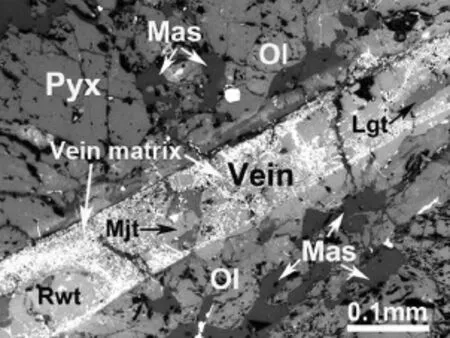
Fig.1 Photomicrograph showing a shock melt vein in the Suizhou meteorite.Note the fragments of ringwoodite(Rwt),majorite(Mjt),and lingunite(Lgt)in the fine-grained vein matrix.Ol olivine;Pyx pyroxene;Mas maskelynite
3 Results
Our optical and TEM studies on Suizhou vein matrix revealed four mineral phases:three fine-grained highpressure mineral phases and the FeNi-FeS intergrowths. The main features of these minerals are as follows.
3.1 Euhedral garnet crystals
Garnet is the main constituent mineral of the vein matrix,and is the first product of crystallization from the shockproduced dense silicate melt.Most of the garnet crystals observed had grain size of 1-2 μm,but crystals larger than 6 μm were also observed.
Chemical compositions of garnet crystals smaller than 2.5 μm in size were analyzed by EDS,and those larger than 5 μm in size by electron probe micro-analysis(EPMA).Results of analyses are presented in Table 1.The larger garnet crystals were rather homogeneous while the smaller ones showed some heterogeneity in SiO2,MgO,and FeO contents.However,both coarse-grained and finegrained samples showed increased Al2O3and CaO contents,and probably increased Na2O as well,in comparison with their precursor pyroxene in the Suizhou meteorite(Table 1).On the basis of its higher Al2O3content(3.51 wt%)than that in pyroxene(0.16 wt%),this garnet mineral was identified as majorite-pyrope in solid solution.
Under TEM,garnet crystals were transparent and no internal microstructures were observed(Fig.2).The garnet crystals,which displayed a smooth surface and irregular shape,appeared randomly distributed in the vein matrix. Most of the ring-like SAED(Fig.2)was indexed as garnet mineral(JCPDS No.25-0843),supported by the agreement between the experimental and simulated patterns(indicated by red line).The appearance of this ring-like SAED pattern indicates that the garnet minerals in vein matrix havedifferent orientations.On the other hand,SAED patterns along theand[110]Gtzone axes(Figs.3,4)were also observed in the garnet crystals(the subscript‘‘Gt’’denotes the garnet mineral).The diffraction spots obtained for majorite-pyrope garnet were sharp,indicating good crystallinity.
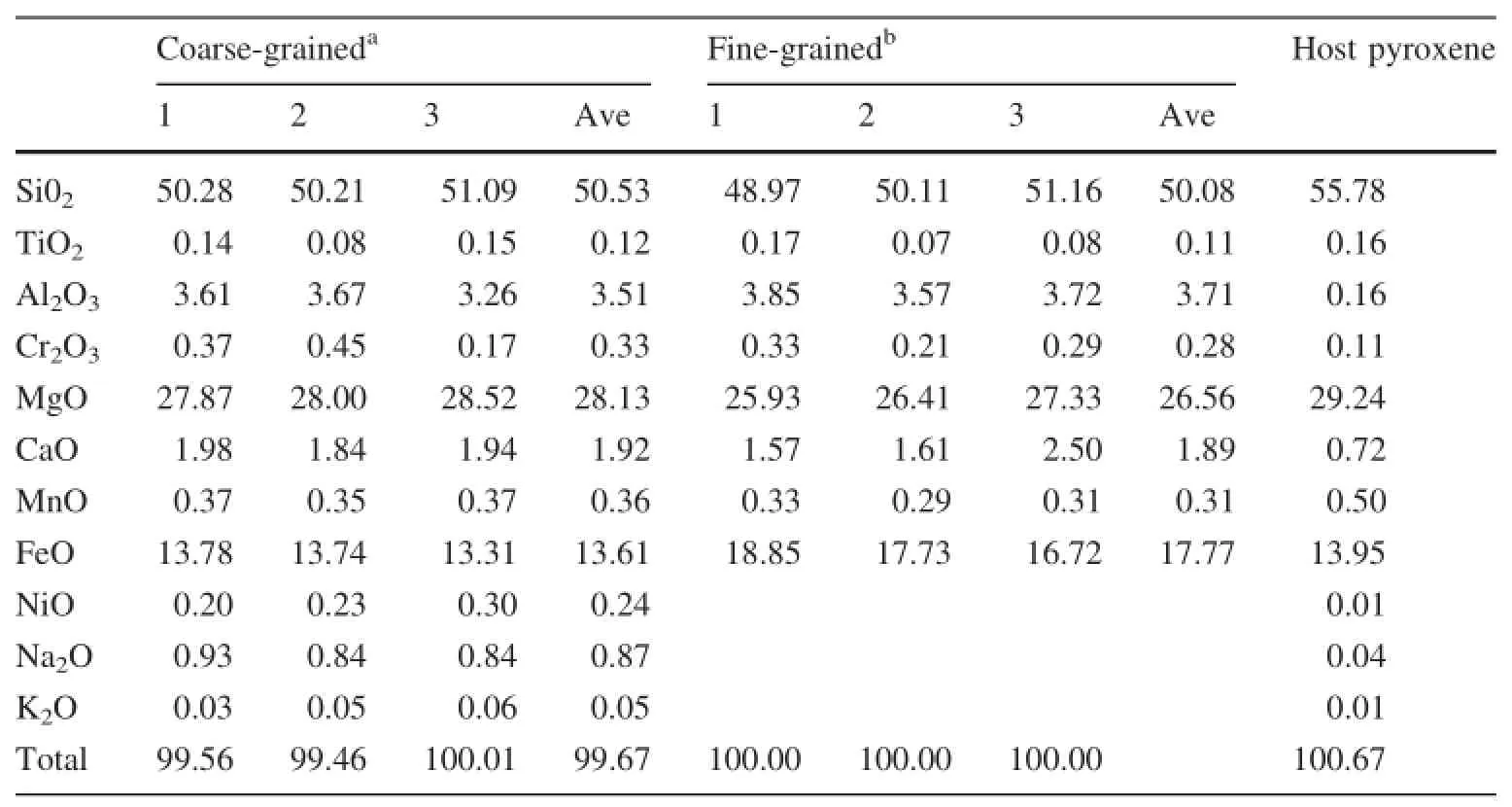
Table 1 Chemical composition of majorite-pyrope garnet in Suizhou veins(wt%)
3.2 Irregular polycrystalline grains of magnesiowu¨stite
Magnesiowu¨stite,(Mg,Fe)O,is the second most abundant mineral in the Suizhou vein matrix.It fills the interstices between garnet crystals,implying that magnesiowu¨stite crystallized after solidification of garnet in veins(Figs.2,5).Compositions of magnesiowu¨stite in the Suizhou veins were measured by EDS and the obtained results are as follows(in wt%):MgO,35.45;FeO,62.16;TiO2,0.20;Cr2O3,0.92;and SiO2,0.37(total:99.10).The sample’s empiric formula was determined to be Wu¨53-Per47,where Wu¨is wu¨stite,and Per is periclase.
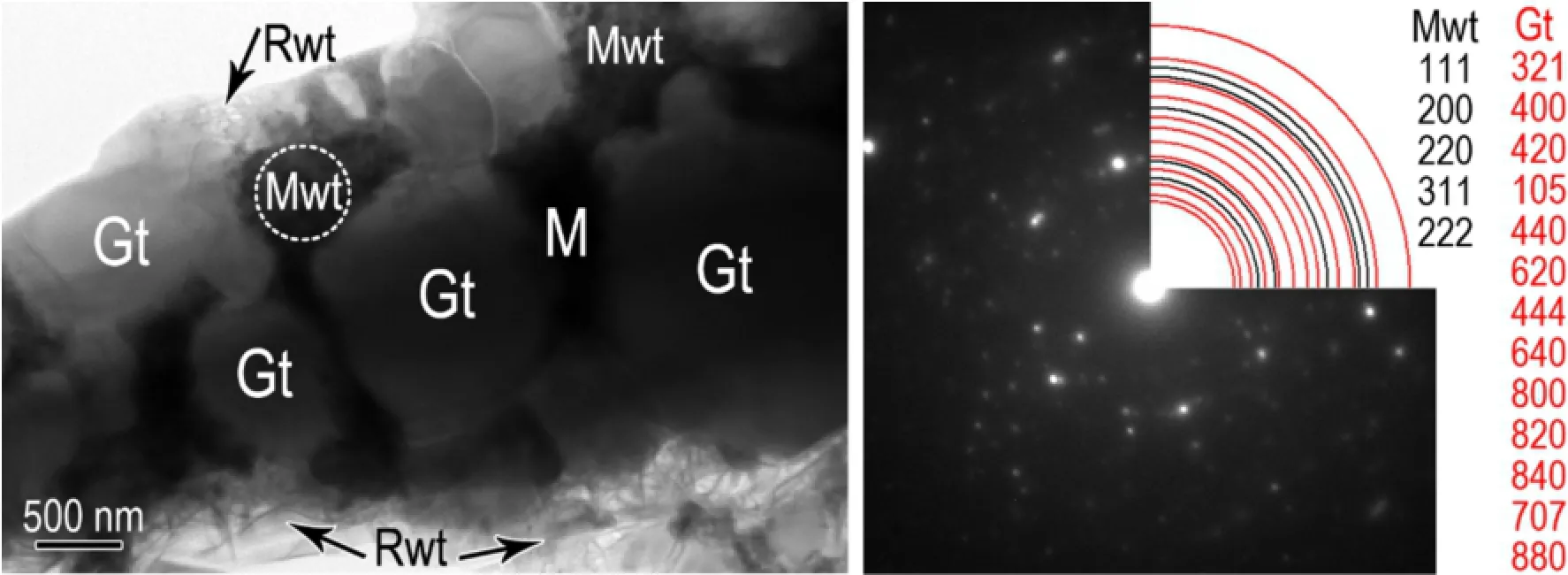
Fig.2 Bright-field TEM image(left)showing the occurrence of three composed minerals in the Suizhou vein matrix:idiomorphic crystals of majorite-pyrope garnet(Gt),irregular grains of magnesiowu¨stite(Mwt)in the interstices of garnets,and cryptocrystalline ringwoodite(Rwt)in the upper and lower parts of the image.The SAED pattern(right)is taken from both garnet crystal and polycrystalline magnesiowu¨stite(white circle).M FeNi metal
Under TEM,this mineral showed a clear polycrystalline nature(Fig.3).The diameter of the polycrystalline grains ranged from several tens of nanometers to several hundred nanometers.The calculatedelectron diffraction lines(indicated by black lines)in Fig.2 were compared with those of periclase(MgO)in JCPDS No.4-289.The slight increase in d-values was linked to the presence of FeO.The polycrystalline nature of magnesiowu¨stite was confirmed in this study by the ring-like SAED pattern(Fig.2).In addition,the SAED pattern along the[120]Mwtzone axisshowed sharp diffraction spots(Fig.5),signifying the good crystallinity of magnesiowu¨stite(the subscript‘‘Mwt’’denotes the magnesiowu¨stite).
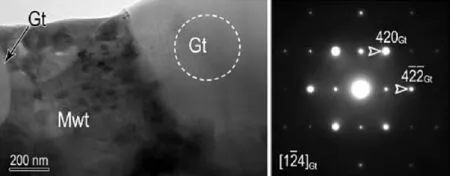
Fig.3 Bright-field TEM image(left)showing majorite-pyrope garnet(Gt)crystals in contact with a magnesiowu¨stite(Mwt)grain.Note the polycrystalline nature of this magnesiowu¨stite grain.The righthand image shows the SAED pattern of garnet with zone axis=[1¯24]Gt
3.3 Irregular cryptocrystalline grains of ringwoodite
Ringwoodite was observed in the Suizhou veins either in the form of narrow independent bands of 2-3 μm in width(Figs.2,4,6),or as irregular grains filling the interstices between garnet crystals or garnet and magnesiowu¨stite grains(Figs.5,6).Under TEM,the ringwoodite appeared transparent,but with a lot of microfractures of different directions probably formed by volume shrinkage during cooling(Figs.5,6,7).Their SAED pattern showed only diffuse concentric diffraction rings(Fig.5).The SAED pattern is identical to the reflections of ringwoodite in JCPDS No.21-1258.It should be pointed out that some individual garnet grains might be embedded in the ringwoodite aggregate(Fig.7).
3.4 Eutectic intergrowths of FeNi-metal and troilite
FeNi metal and troilite(FeS),which were molten during the shock event,were observed in Suizhou vein matrix as fine eutectic FeNi-FeS intergrowths filling the interstices between the fine-grained high-pressure minerals garnet and magnesiowu¨stite(Figs.2,6).The FeNi metal+FeS intergrowth grains were too small to distinguish the two constituent FeNi and FeS phases.EDS analyses on three such intergrowth grains revealed that these grains consist of Fe(90.98-92.82 wt%),Ni(3.34-6.14 wt%)and S(3.60-5.61 wt%),reflecting the common composition of these two phases.
4 Discussion
High-pressure minerals occurring in shocked meteorites are formed either by crystallization of silicate liquids in melt veins and pockets,or by solid state transformation of the constituent minerals in the meteorite(Chen et al.1996). Although solid-state phase transformations can provide important constraints on shock conditions of a meteorite,transformation pressures are difficult to calibrate accurately because of kinetic effects and the heterogeneous nature of the initial transient shock pressures(Sharp and DeCarli 2006).Crystallization of chondritic melt provides an alternative means of constraining the crystallization pressure,which can be related to the shock pressure of the sample(Sharp and DeCarli 2006).Thus,our TEM results of the Suizhou vein matrix minerals that crystallized from shock-induced chondritic melt provide important information about the shock pressure experienced by this meteorite.This approach was first used by Chen et al.(1996),who used TEM to determine melt-vein assemblages in the Sixiangkou L6 meteorite.They found that the chondritic melt in a large melt vein crystallized to form majoritic garnet and magnesiowu¨stite,which,based on the phase diagram of the CV3 chondrite Allende(Agee et al.1995)are stable at pressures between about 22 and 27 GPa.Chen et al.(1996)inferred a crystallization pressure of about 25 GPa.
The experimentally obtained phase diagram by Zhang and Herzberg(1994)for anhydrous peridotite KLB-1 shows that majoritic garnet and magnesiowu¨stite crystallized from silicate melt at pressures between 20 and 25 GPa.This result is close to that(22-27 GPa)given by Agee et al.(1995).Hence,it is reasonable to assume 20-26 GPa to be the crystallization pressure for these two high-pressure minerals.The phase diagrams given by Agee et al.(1995)and Zhang and Herzberg(1994)also demonstrate that ringwoodite crystallized at pressures between 18 and 20 GPa.Based on these two phase diagrams and the crystallization sequence of the three fine-grained highpressure minerals revealed by our TEM study,we assumethat majorite-pyrope garnet first crystallized from the Suizhou chondritic melt at 22-26 GPa,followed by crystallization of magnesiowu¨stite at 20-24 GPa,and then ringwoodite at 18-20 GPa.The eutectic intergrowths of FeNi-metal and troilite crystallized during meteorite cooling and solidified at the last stage of vein formation.
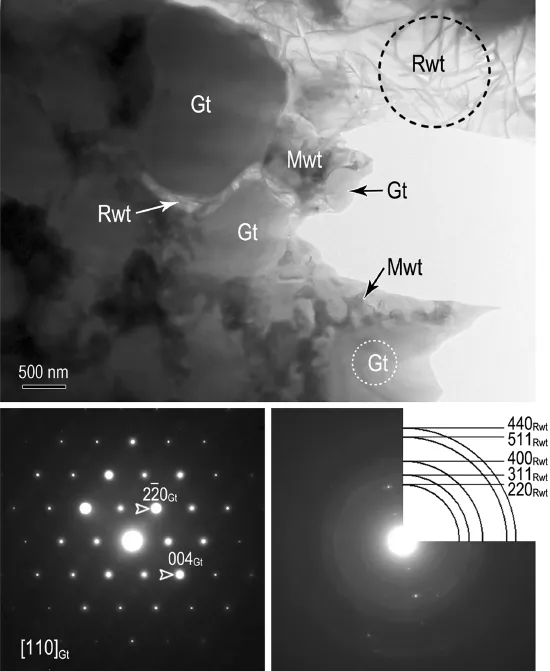
Fig.4 Bright-field TEM image(upper)showing the two occurrences of cryptocrystalline ringwoodite(Rwt):one is in the form of an independent band in the upper right part of the image;another is filling the interstices of garnet(Gt)crystals.The lower left SAED pattern is taken from a garnet crystal,and the lower right SAED pattern is from cryptocrystalline ringwoodite
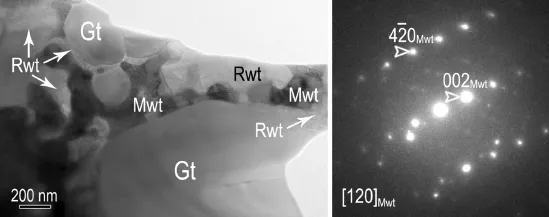
Fig.5 Bright-field TEM image(left)showing idiomorphic garnet(Gt)crystals of different sizes and magnesiowu¨stite(Mwt)and cryptocrystalline ringwoodite(Rwt)grains in the interstices of garnets.The righthand image shows the SAED pattern of magnesiowu¨stite with zone axis=[120]Mwt
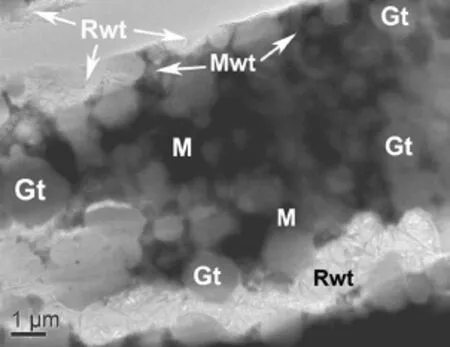
Fig.6 Bright-field TEM image showing the occurrence of three composed minerals in the Suizhou vein matrix:idiomorphic crystals of garnet(Gt),irregular grains of magnesiowu¨stite(Mwt),and FeNi+FeS intergrowths(M)in the interstices of garnets and two bands of cryptocrystalline ringwoodite(Rwt)in the upper and lower parts of the image
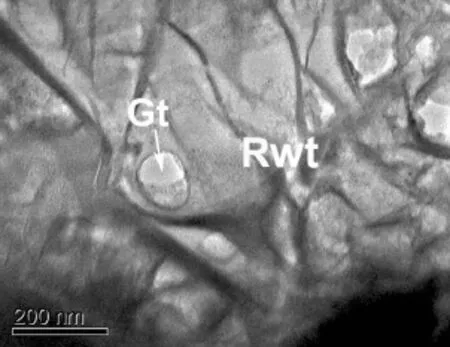
Fig.7 Bright-field TEM image showing the internal microstructure of cryptocrystalline ringwoodite(Rwt).Note a small,round grain of garnet(Gt)is embedded in ringwoodite
It is known that majoritic garnet is the high-pressure polymorph of pyroxene and ringwoodite is the high-pressure polymorph of olivine.Both are main constituent mineral phases in the transition zone of Earth’s mantle. Additionally,magnesiowu¨stite is one of the main constituent mineral phases of the Earth’s lower mantle.Hence,the results of this TEM study are of great significance in understanding Earth’s mantle mineralogy.
AcknowledgmentsThis study is financially supported by National Natural Science foundation of China under Grant 41172046 and 40972044 in part.We wish to thank Lei Jin for his help in sample preparation.
Agee CB,Li J,Shannon MC,Circone S(1995)Pressure-temperature phasediagramforAllendemeteorite.JGeophysRes 100:17725-17740
Binns RA,Davis RJ,Read SJB(1969)Ringwoodite,a natural(Mg,Fe)2SiO4 spinel in the Tenham meteorite.Nature 221:943-944
Chen M,Xie X(1997)Shock effects and history of the Yanzhuang meteorite:a case different from the L-chondrites.Chin Sci Bull 42:1889-1893
Chen M,Xie XD(2015)Shock-produced akimotoite in the Suizhou L6 chondrite.J Sci China·Earth Sci 58:876-880
Chen M,Sharp TG,El Goresy A,Wopenka B,Xie X(1996)The majorite-pyrope+magnesiuwu¨stite assemblage:constraints on the history of shock veins in chondrites.Science 271:1570-1573
Chen M,Shu J,Mao HK,Xie XD,Hemley RJ(2003)Natural occurrence and synthesis of two new postspinel polymorphs of chromite.Proc Natl Acad Sci USA 100(25):14651-14654
Chen M,Xie XD,El Gores A(2004)A shock-produced(Mg,Fe)SiO3 glass in the Suizhou meteorite.Meteor Planet Sci 39:1797-1808
Chen M,Shu JF,Mao HK(2008)Xieite,a new mineral of highpressure FeCr2O4polymorph.Chin Sci Bull 53:3341-3345
Coleman LC(1977)Ringwoodite and majorite in the Catherwood meteorite.Can Mineral 15:97-101
Kimura M,El Goresy A,Suzuki A,Ohtani E(1999)Heavily shocked Antarctic H-chondrites:petrology and shock history.Antarct Meteor 24:67-68
Kimura M,Chen M,Yoshida T,El Goresy A,Ohtani E(2002)The first discovery of back transformation of high-pressure phases in shock veins of ordinary chondrites during atmospheric passage. Antarct Meteor 27:55-56
Madon M,Poirier JP(1979)Dislocation in spinel and garnet highpressure polymorphs of olivine and pyroxene:implications for mantle rheology.Science 207:66-68
Sharp TG,DeCarli PS(2006)Shock effects in Meteorites.In:Binzel RP(ed)Meteorites and the early solar system II.The University of Arizona Press,Tucson,pp 653-677
Smith JV,Mason B(1970)Pyroxene-garnet transformation in Coorara meteorite.Science 168:822-823
Xie X,Chen M,Wang D(2001)Shock-related mineralogical features and P-T history of the Suizhou L6 chondrite.Eur J Mineral 13:1177-1190
Xie XD,Minitti ME,Chen M,Wang DQ,Mao HK,Shu JF,Fei YW(2003)Tuite,γ-Ca3(PO4)2,a new phosphate mineral from the Suizhou L6 chondrite.Eur J Mineral 15:1001-1005
Xie XD,Sun ZY,Chen M(2011)The distinct morphological and petrological features of shock melt veins in the Suizhou L6 chondrite.Meteor Planet Sci 46:459-469
Xie XD,Zhai SM,Chen M,Yang HX(2013)Tuite,γ-Ca3(PO4)2,formed from chlorapatite decomposition in the shock vein of the Suizhou L6 chondrite.Meteor Planet Sci 48:1515-1523
Zhang J,Herzberg C(1994)Melting experiments on anhydrous peridotite KLB-1 from 5.0 to 22.5 GPa.J Geophys Res 99:17729-17742
31 August 2015/Revised:21 December 2015/Accepted:18 January 2016/Published online:30 January 2016ⒸScience Press,Institute of Geochemistry,CAS and Springer-Verlag Berlin Heidelberg 2016
杂志排行
Acta Geochimica的其它文章
- An optimized sequential extraction scheme for molybdenum association in environmental samples
- Nutrient uptake by mulberry and Chinese prickly ash associated with arbuscular mycorrhizal fungi
- Quantification of photosynthetic inorganic carbon utilisation via a bidirectional stable carbon isotope tracer
- Tin partition behavior and implications for the Furong tin ore formation associated with peralkaline intrusive granite in Hunan Province,China
- Improvement of saponification extraction method for fatty acids separation from geological samples
- Zircon U-Pb dating of Pubei granite and strontium isotope from sphalerite of the Xinhua Pb-Zn-(Ag)deposit,Yunkai Area of Guangxi Province,South China
